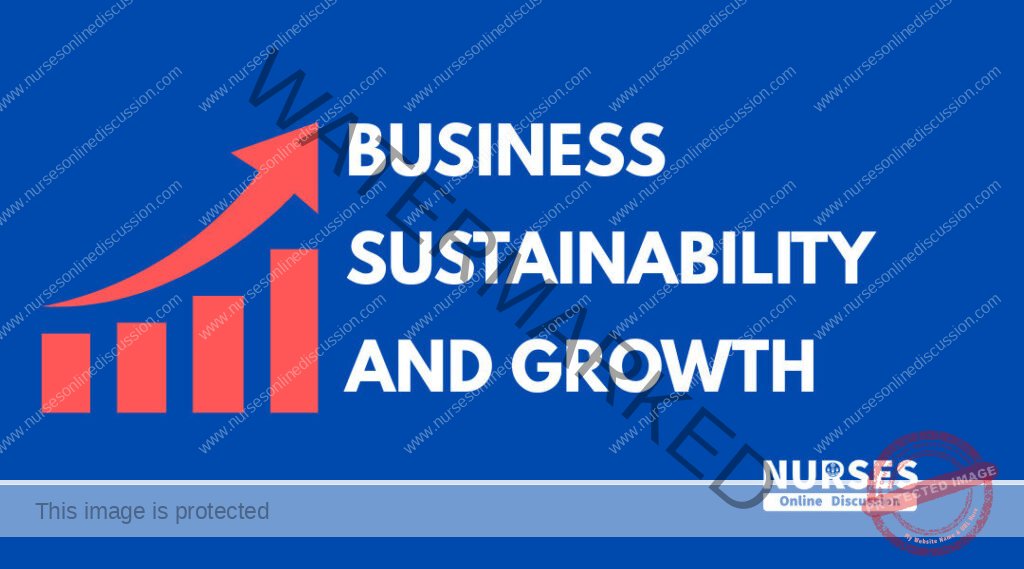Entrepreneurship
Subtopic:
Business Sustainability and Growth
Table of Contents

Business Sustainability and Growth
1. Definition
Business Sustainability refers to the ability of a business to operate over the long term by efficiently managing its financial, environmental, and social resources. A sustainable business can maintain its operations without exhausting its resources or harming its social or ecological environment.
Growth refers to the increase in a business’s size, revenue, customer base, market share, or output. It indicates progress and expansion through improved efficiency, innovation, and profitability.
Sustainable Competitive Advantage is a lasting edge over competitors that enables a business to survive and thrive over a long period. This may result from unique products, strong brand reputation, loyal customers, cost advantages, or innovation.

2. Forms of Sustainability
Financial Sustainability
The ability of a business to finance itself independently through its own revenue streams.
Ensures the business can cover operational costs and invest in future development.
Resource Sustainability
The ability of business resources (such as labor, raw materials, technology) to multiply or renew themselves.
Encourages efficient use and replenishment of resources to support continued operations.
Impact Sustainability
The ability of a business’s positive effect on its customers and community to continue over time without requiring significant new inputs.
This includes maintaining goodwill, customer loyalty, and community development impact.
Environmental Sustainability
Conducting business in a way that minimizes harm to the environment.
Includes reducing waste, using renewable energy, and promoting eco-friendly practices.
Social Sustainability
Ensuring fair labor practices, equitable treatment, and long-term benefits for employees and communities.
3. Strategies for Ensuring Sustainability
Revenue Diversification
Offer a wide range of products or services to reduce overreliance on a single income stream.Lobbying for Diverse Donations or Support
Source financial support from various donors, government programs, or NGOs.Community Involvement through Training
Engage community members in business activities and offer training to prepare for future leadership or succession.Insuring the Business
Protect against risks like fire, accidents, or theft through appropriate insurance policies.Employee Training and Capacity Building
Continuously update employee skills to improve service delivery, adaptability, and innovation.Product/Service Diversification
Broaden product or service offerings to cushion against market fluctuations or seasonal changes.Government Support and Policy Engagement
Seek tax incentives, subsidies, or favorable business policies.Community Engagement and Acceptance
Build strong relationships with local leaders and groups to ensure continued community support.Corporate Social Responsibility (CSR)
Support community initiatives like road maintenance, health campaigns, water source protection, and education.Reinvesting Profits (Ploughing Back)
Use business profits to expand, upgrade, or improve the business infrastructure and operations.Encouraging Savings for Future Investment
Maintain business savings to fund future projects or to buffer against financial shocks.Using Locally Available Resources
Substitute expensive imported materials with affordable, readily available local inputs.Technology Adoption
Embrace technology for marketing, inventory management, and automation to increase efficiency.Environmental Management
Implement eco-friendly practices like recycling and sustainable waste disposal.
4. Importance of Planning for Growth
Guides Expansion: Helps identify when, how, and where the business should grow.
Resource Allocation: Ensures the efficient use of capital, human resources, and time.
Innovation: Facilitates the introduction of new products or services.
Risk Reduction: Minimizes the chances of failure through careful planning and forecasting.
Market Competitiveness: Helps maintain a competitive edge by adapting to changes.
Vision and Focus: Establishes clear goals and direction for the business.
5. Characteristics of a Good Business Opportunity
Good Growth Potential: The opportunity must be able to survive and thrive while generating adequate returns.
Strong Market Demand: Must show signs of increasing customer need or acceptance.
Innovation or Product Newness: Brings something new or improved to the market.
Economic Alignment: Fits within favorable economic and industry trends.
Scalability: Can be expanded easily with available resources.
Profitability: Expected to generate sufficient returns on investment.
6. Indicators of Rapid Market Growth and High Return
Projected increase in customer demand.
Strong customer acceptance and feedback.
The uniqueness of the product or service.
Positive economic trends that encourage consumption or investment.
Ability to attract repeat business.
7. Challenges to Growth and Sustainability
Limited Access to Capital: Entrepreneurs may struggle to obtain loans or investment due to lack of collateral.
Over-Expansion: Growing too fast without the necessary systems, people, or resources in place.
Poor Planning and Management: Lack of clear direction or expertise can lead to failure.
Economic Instability: Changes in inflation, interest rates, or market demand can hurt sustainability.
Technological Lag: Falling behind in adopting necessary technologies can reduce efficiency and competitiveness.
Market Saturation: Intense competition in saturated markets can limit profitability.
Regulatory Challenges: High taxes, complex licensing, or policy changes can hinder growth.
8. Contributions of Business Growth to Broader Economic Development
Job Creation: Provides employment opportunities that reduce poverty and improve livelihoods.
Increased Government Revenue: Through taxes, fees, and contributions to national revenue.
GDP and GNP Growth: Increased production and services contribute to national economic indicators.
Infrastructure Development: Businesses often invest in transport, communication, and utilities.
Entrepreneurial Culture: Fosters innovation, problem-solving, and resilience.
Better Living Standards: Improves access to goods, services, and opportunities for the population.
Stimulates Other Sectors: Growth in one business can create demand for services or products in other industries.
Get in Touch
(+256) 790 036 252
(+256) 748 324 644
Info@nursesonlinediscussion.com
Kampala ,Uganda
© 2025 Nurses online discussion. All Rights Reserved Design & Developed by Opensigma.co

